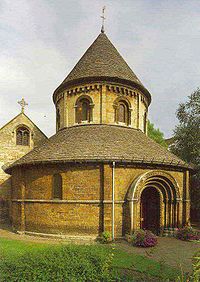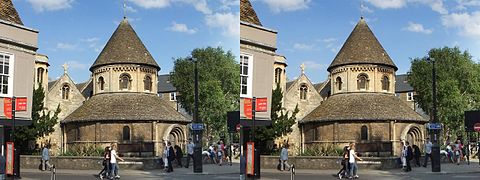The Holy Sepulchre, Cambridge
| The Round Church, Cambridge | |
|---|---|
| Church of the Holy Sepulchre | |

West front of the Church of the Holy Sepulchre, Cambridge
|
|
| Coordinates: 52°12′30″N 0°07′08″E / 52.2084°N 0.1189°E | |
| OS grid reference | TL 448 588 |
| Location | Cambridge |
| Country | England |
| Denomination | Anglican |
| Website | The Round Church |
| History | |
| Founded | c. 1130 |
| Architecture | |
| Functional status | Parish Church |
| Heritage designation | Grade I |
| Designated | 26 April 1950 |
| Architect(s) | Anthony Salvin (restoration) |
| Architectural type | Church |
| Style | Norman, Gothic Revival |
| Completed | 1842 |
| Closed | N/A |
| Specifications | |
| Materials | Stone |
| Stereo image
|
||
|
||
|
||
|
||
|
||
| The Round Church and the south end of Round Church Street. |
The Church of the Holy Sepulchre, universally known as The Round Church, is an Anglican church in the city of Cambridge, England'. It is located on the corner of Round Church Street and Bridge Street. Since 1950 the church has been designated a Grade I listed building, and is currently managed by Christian Heritage. It is one of the four medieval round churches still in use in England.
The church was built around 1130, its shape being inspired by the rotunda in the church of the Holy Sepulchre, Jerusalem. It was built by the Fraternity of the Holy Sepulchre, who were probably a group of Austin canons. It consisted of a round nave and an ambulatory, with a short chancel, probably in the shape of an apse. Initially it was a wayfarers' chapel on the Roman road known as Via Devana (this is now Bridge Street). By the middle of the 13th century it had become a parish church under the patronage of Barnwell Priory. Around this time structural alterations were made to the church, with the rebuilding of the chancel and the addition of a north aisle, the aisle being shorter than the chancel. During the 15th century the Norman style windows in the nave were replaced by larger Gothic style windows. The carvings of angels in the roofs of the chancel and aisle were added. A polygonal bell-storey was built over the nave. In 1643, during the Civil War, many of the "idolatrous" images were destroyed. By the 19th century the church was in a poor state of repair. Part of the ambulatory collapsed in 1841, and the Cambridge Camden Society offered to carry out repairs. They appointed Anthony Salvin for the purpose.
...
Wikipedia


